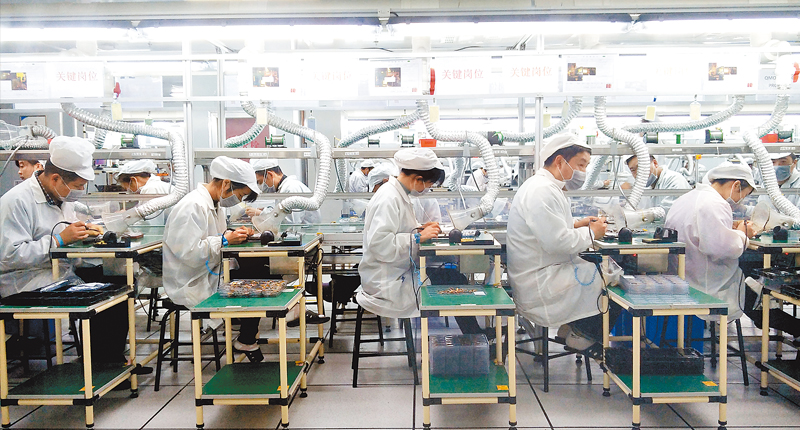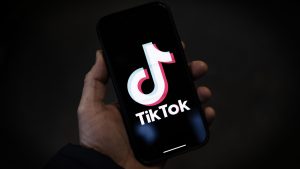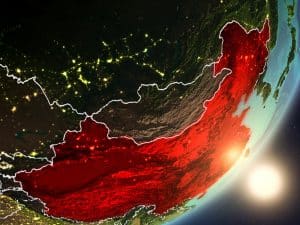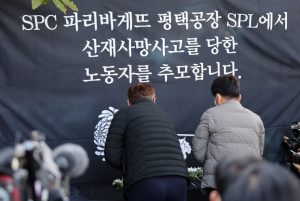At just one iPhone plant in Zhengzhou, China, Foxconn employs more than 200,000 workers; it is telling that this industrial complex is often referred to as an “iPhone city.” Workers work and sleep at the industrial complex, which includes both cafeterias and dormitories. Since Chinese authorities began the so-called Covid Zero policies, with widespread lockdowns and quarantines, conditions at the factory are especially restrictive. Millions of workers have fled factories in recent months in order to avoid being locked down inside. In late November, protests erupted, led by new workers who had been promised salary increases that never materialized. Images of the rebellion went viral across the web, with workers facing off against the police inside the factory. The conditions of extreme exploitation at Foxconn’s factories, made clear by the workers’ rebellions, are, in fact, key to the success of corporations like Apple.
This following interview with author and researcher Jenny Chan was originally published in La Izquierda Diario on November 24, 2022. It has been lightly edited for length and clarity.
What was the cause of these protests by Foxconn workers?
The immediate reason is wages and bonuses. The workers understand the terms and conditions based on the company information when they decided to go to work Foxconn. So, they go in with high expectations.
The workers first had to undergo a COVID quarantine in their hometown, which has lasted for three days. They also had COVID testing every day. Then, local officials, or agencies, would send them by bus to Foxconn. Once they arrived at Foxconn’s factory in the Zhengzhou Airport Economy Zone, after some more COVID checks, they got to work.
The first group of new workers, possibly including the returning workers who had fled the compound earlier, arrived on November 13. They found out that Foxconn provided them with a contract that had lower wages and they might not get the big bonuses either.
Based on the available information, including video footage, the violent clashes were believed to be triggered by a broken managerial promise regarding pays and bonuses. Workers were angry and disappointed about Foxconn’s failure to keep its promise. It looked like Foxconn requires workers to work a lot more before they can ultimately get the high wages and bonuses.
When workers refused to sign the contracts—involving not just a few workers but many workers, in the thousands or even tens of thousands—something must be very wrong. They know their rights. They have been hoping to get quick money for their kids and families towards the end of the year.
I cannot accept the excuse that the “riot” was merely due to a miscommunication with workers, or a technical problem of data entry. Fundamentally, Foxconn is pressured to control rising labor costs, and it is maximizing profits amid COVID.
Can you tell us how COVID measures affected workers?
COVID restrictions have been in place for nearly three years in China. People have difficulties traveling. When restaurants or shops are closed, workers cannot meet with friends. In October, in Zhengzhou city, COVID cases went up, and since then the measures have tightened.
I should add that, based on government statistics, the case numbers had actually been quite low, mostly in the single digits. However, the Chinese authorities have implemented very strict policies like COVID lockdowns.
From mid-October onwards, Foxconn operated in “closed-loop” management, or a self-contained bubble, where workers must commute between their dormitories and factory workshops. The “point-to-point” closed system is adopted to maintain iPhone production while minimizing the spread of COVID virus. Workers are, in effect, isolated from the bigger city.
Things got worse when workers reported that some were tested positive. However, Foxconn has never announced the exact number of COVID cases onsite. Factory canteens were soon closed down. Workers were provided with boxed meals, but the food quality was often not good. Later, some complained that they had no access to food.
There are more than 200,000 workers in this Zhengzhou factory. Foxconn divides the huge manufacturing site into different zones, labelled in English letters, like A, B, and C. All the workers are making the iPhone 14 Pro and iPhone 14 Pro Max. One product. One client — Apple.
Workers go to work, either on foot from nearby dormitories or by company shuttle bus. They work, go to sleep, and then work again. Even if you’re a healthy person, you just can’t work all day long, with lots of overtime work, as iPhone production is already behind the schedule.
Before COVID, young workers had some fun or leisure after work, like skating, dating, or celebrating birthdays with friends. Over this past month or so, in the closed-loop production mode, workers could only play with their smartphones, or use their phones to talk to friends and families.
Above all, there is a sense of fear. In the dormitories and the factories, one doesn’t know whether another worker is infected with COVID. In some dorm rooms, as many as 12 people live together, sharing the bathroom. Some do not know each other well since workers are from different shifts, day and night, and from different hometowns.
When workers had a fever or a cough, they didn’t seem to have adequate medical care. This is stressful and frightening. Foxconn has been mobilizing the local governments to recruit new workers as many left, or escaped. As I mentioned, Foxconn received the first batch of new workers on November 13. Unfortunately, when workers felt that they were cheated, violent clashes broke out. The others seemed to raise the concern of continued COVID infections in the dormitories, which is a yet-to-resolve discontent.
Foxconn and Apple are concerned about high-speed production. It’s a chaotic situation, coercive and exploitative. There’s no transparency about the COVID situation. Workers were worried about the impact of COVID, so much so that some believed that they’d die if they didn’t leave Foxconn.
The Foxconn Trade Union is dominated by senior management. Apparently, they refused to sign the “illegal” or “unreasonable” job contracts. They take matters into their own hands. Video footage shows that workers were beaten up and left bloody by the police. Terrifying scenes.
Are these kinds of protests frequent?
A very good question. Fundamentally, the collective power of workers remains relatively weak. In the absence of institutional representation, say, through a functioning trade union, workers have to rely on themselves. When workers could not tolerate the situation anymore, protests and strikes erupted. Over these past few weeks, crackdowns on workers, non-governmental organizations, human rights lawyers and other groups were severe. I believe that strikes, protests and riots happened from time to time but the risks were high.
It’s very challenging to track exactly the numbers of labor protests per year in China, given the Internet surveillance and other forms of monitoring by the authorities. The Hong Kong-based China Labour Bulletin has been updating a map to show the geography and reports of labor strikes and protests, which relies on available online information, including workers’ social media data. Overall, I think that the total number of labor protests has gone down, or these events are harder to trace nowadays.
Can you talk a little more about how life is like in that city of iPhone?
Foxconn has more than 40 production sites throughout coastal and inland China. This Zhengzhou factory—known as the “iPhone city” within the city—is just one of the Foxconn factories. It has more than 200,000 workers right now. The provision of dormitories is primarily to keep labor cost low, otherwise, Foxconn has to pay a lot more to attract migrant workers. Sleep, eat, and regain labor power to work the other day. This is how daily reproduction at Foxconn is managed. Keep in mind that dorms are not provided for couples or families. Male and female workers are separated by gender-segregated dorms.
Outside of the “factory city,” due to COVID curbs, mobility remains low or severely restricted. The Chinese government is anxious about COVID prevention. Residential districts in Zhengzhou, for example, are shut down in specific periods when there are confirmed COVID cases. Local residents are not authorized to go out or come in during quarantines. Schools and universities were temporarily closed; classes were held online; libraries were shut. Subways and buses are not publicly accessible, unless the COVID measures are lifted.
Videos, photos or blog posts are often removed quickly by the censors. Local journalists also find it difficult to get the first-person voice from workers. I understand that big media organizations do not necessarily have reporters stationed in China. Over the past few years, high-profile journalists were rejected renewals of work visas.
Our book, Dying for an iPhone, was completed just before the COVID outbreak. In January 2020, I made my last trip to a southern city on mainland China, thereafter, I’ve been staying in Hong Kong. What I can share is based on extensive reading and interviews.
In labor-intensive manufacturing, Foxconn’s profit-margin remains low. Yet, Foxconn is also capital intensive; it invests in robots and high-end machineries and huge computers to enhance production efficiency. To cut costs and increase flexibility, Foxconn and many others deploy hourly-paid workers, agency workers, and students from vocational schools in what are called “internships.” Foxconn needs a large number of workers, over 100,000 people, to fill the place! This latest round of recruitment, just as in the past, goes deep to villages, far and near. Apple pressures Foxconn to ramp up iPhone production as the wait times have lengthened in this holiday shopping season.
The last question, are you writing a new essay?
Yes, I’m writing about what’s been going on these months, while also providing a historical perspective, like the expansion of Foxconn in China, the rise of the iPhone city. As long as the militaristic management methods remain unchanged, workers will suffer, or Foxconn will stir another wave of labor unrest. This is the major crisis in transnational or global production.
Workers’ lives are worth nothing for the company.
Nothing, indeed.











